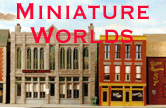
Climax Class A horizontal boiler logging locomotive manufactured by Nakamura Seimitsu K.K. [Its box has an American address but no importer: 1801 Dalehurst, Los Altos CA 94022)]. I had this beautiful little made-in-Japan brass engine re-motored, lighting added, and converted to DCC a number of years ago. It has its original paint job, to which I have added wooden planking beneath the water tank, a rerailer, jack, and wood fuel. The "GL" stands for Glanville Lumber company, which I named after Joe Glanville, who ran a tiny model railroad shop at the back of his son's gas station in East Providence, Rhode Island, and who sold me — really gave me — the engine for $25.00 because neither of us could get it working.


Left: The opposite side of the engine shown above. Right: The engineer backs the lumber company’s tank car across a trestle. [Click on images to enlarge them.]
As Michael Koch explains in Steam and Thunder in the Timber,
The Climax locomotives were offered in three classes, referred to in their catalogue as Class A, Class B. and Class C. Class A locomotives ranged from 12- to 22-ton sizes. Class B locomotives lacked the gear-shift feature and ranged in size from 17 to 62 tons. On these the position of the cylinders was hanged to an angle of about 25 tons with the horizontal. This inclination of the cylinder was a chaacteristic of the Class B Climaxes, making them instantly recognizable. Class C locomotives could be had in weights from 70 to 100 tons. [Koch, p. 50 GPL].



Right: The Climax pulls the assembled train consisting of one of the railroad's caboose, a 4-wheel boxcar, and a tank car back across the trestle. [Click on images to enlarge them.]

Bibliography
Labbe, John T., and Vernon Goe. Railroads in the Woods. Berkeley, California: Howell-North, 1961, p. 76.
Koch, Michael. Steam and Thunder in the Timber: Saga of the Forest Railroads. Denver: World Press, 1959.

